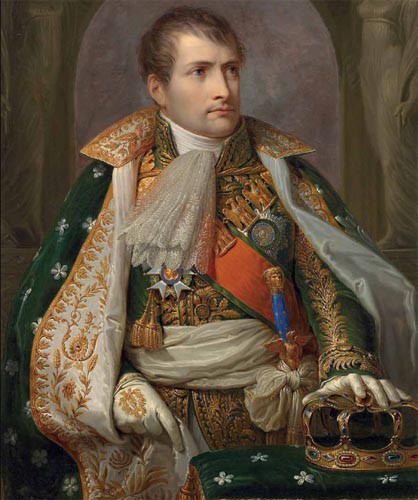Just as French artists were commissioned to immortalise the figure of the emperor after the coronation, so too Italian painters leapt into action after the proclamation in Paris of Napoleon as King of Italy on 17 March, 1805 and the coronation in Milan on 26 May. And for the official portrait, Napoleon turned to the most famous of Milanese painters, Andrea Appiani. The result was a traditional expression of the allpowerfulness of a monarch bearing the attributes of power.
Appiani's relations with Napoleon had begun many years earlier, in 1796 during the First Italian Campaign. As the principle Italian exponent Neoclassicism, and renowned for his talent as a fresco painter, Appiani was called the « painter of the Graces » and even compared to Raphael. His meeting with Bonaparte was significant, since it led to Appiani being showered with honours and commissions, one of which notably was for the decorative cycle for Palace in Milan. He was also much called upon by the high society of the day as a portraitist, and his paintings of Bonaparte (begun in 1796 using sketches) were soon to travel widely in engraving form: general, First Consul, Emperor in his Coronation Robes. When he received the title of «First Painter» in 1805, the artist then painted this famous portrait of Napoleon as King of Italy, known in several versions each with variations (Musée de l'Île d'Aix, Kunsthistorisches Museum in Vienna, Dalmeny House in Scotland, Museo del Risorgimento in Milan).
Not following the grand French tradition of the full length portrait, Appiani here opts for a bust view, giving full emphasis to the regal insignia. Napoleon, three-quarters facing to the right, is wearing the «petit habillement» (undress costume), one similar to that worn for the coronation in Notre-Dame, but embroidered on green rather than purple velvet. The suppliers were however the same, namely, Chevallier for the making of the costume, and Picot for the embroidery. Whilst Napoleon's gaze appears to be 'elsewhere' and his mouth a little severe, the attention paid to the hands is interesting: the right pulls in the cloak to give the composition balance, and the left rests on the crown of the King of Italy, prepared by the jeweller Marguerite. This version of the painting shows the King of Italy without any sort of headwear; the version held by the Musée de l'Île d'Aix on the other hand depicts him wearing the laurel crown of the Emperor of the French. Here, the badge of the Légion d'honneur is replaced by one for the Order of the Iron Crown. It was this crown – worn by the Lombard Kings and held in the Cathedral of Monza – that Napoleon chose first as the symbol of his new kingdom and subsequently as the emblem of his new chivalric order, created on 5 June 1805.
Karine Huguenaud (tr. P.H.)
September 2012
Napoleon I, King of Italy
Artist(s) : APPIANI Andrea

- Date :
- Circa 1805
- Technique :
- Oil on canvas
- Dimensions :
- H = 99 cm, L = 73 cm
- Place held :
- Vienne, Kunsthistorisches Museum, Gemäldegalerie

